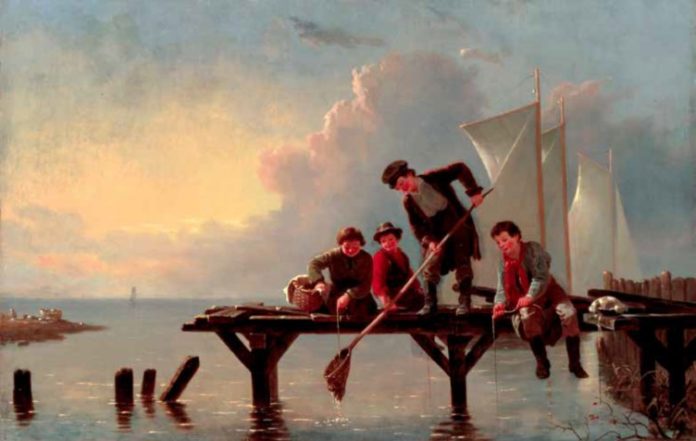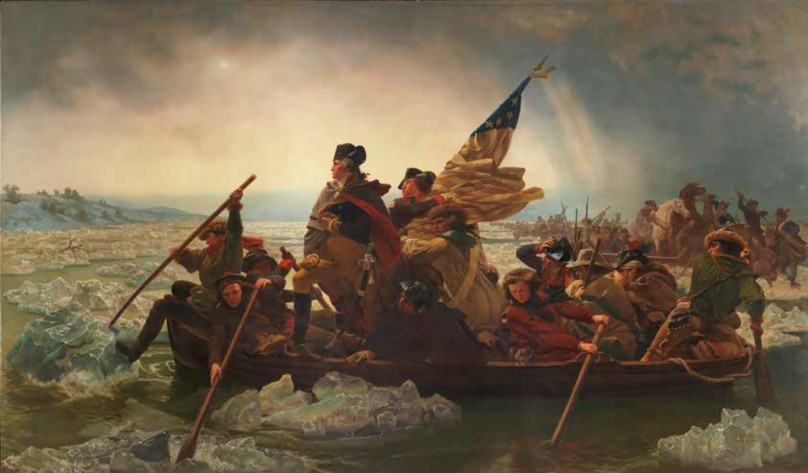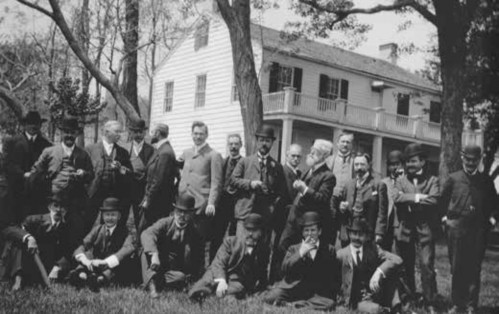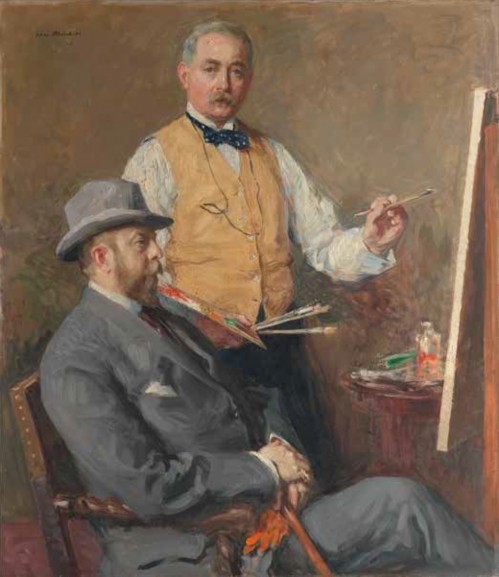
Funding For Artists > A spotlight on the Artists’ Fellowship, a charitable foundation that assists professional visual artists and their families in times of emergency, disability, or bereavement.
BY JONATHAN HARDING
Jonathan Harding (1957–2019) was Curator of the Century Association in New York City.
Many of the causes and charities we support today have antecedents that date back to the 18th century and earlier. Commonly known as benevolent associations, relief organizations, or helpful societies, many were designed to help segments of society before governments began developing social safety nets in the 20th century.
Some of these early charities were based on race or creed, but a healthy portion evolved from medieval guilds and were devoted to professions. The farmer, textile worker, canal laborer, miner, or stonemason would, more likely than not, be a fellow of such a relief organization (precursors to our trade unions), to which he would pay dues or assessments. In return the member and his family would be guaranteed financial assistance in the event of illness or death.
Artists had also been participating in this support system as far back as Europe’s medieval guilds devoted to St. Luke, the patron saint of artists. By the dawn of the 19th century, the artists of many European cities had established relief organizations, including London’s bluntly named “The Artists’ Benevolent Institution for the Relief of Decayed Artists in the United Kingdom,” which J.M.W. Turner helped establish in 1814. The charitable organizations for artists in America came later, and this is the story of one, the Artists’ Fellowship of New York City.
BORN OUT OF NEED
The plight of America’s impoverished artists became evident in 1828, if not before. When the renowned portrait painter Gilbert Stuart died in that year, the Boston Athenaeum organized a memorial exhibition of his portraits for the benefit of his family, and in 1846 the City of New York did the same for its beloved portraitist Henry Inman. By mid-century the reality of such deaths made the artists of cities like Boston, Philadelphia, and New York realize that they needed relief organizations to attend to such eventualities.
The founding of the Artists’ Fellowship dates to 1857 and the premature death of William Ranney, an inspired, up-and-coming painter of the American West. Though Ranney’s talents were well recognized by his fellow artists, he had yet to receive public recognition, and he died leaving his family deeply in debt. The artists of New York City quickly grasped the tragedy of the situation and organized an impromptu auction of his works. To promote the sale, they decided to contribute works of their own. The 1858 exhibition-sale was a great triumph: it raised more than $10,000, which paid off the mortgage on Ranney’s house in West Hoboken, New Jersey, and established a fund for support of his wife and children. Such was the success of this event that a number of artists suggested that a more formal helpful society be created, one designed to assist artists’ families in future times of need.
In this spirit the Artists’ Fund Society of New York was created, with the artists Thomas Seir Cummings and Charles Loring Elliott leading the effort. By their design, the society would follow the formula that had just proven so successful for supporting the widows and children of artists — organizing estate auctions and donating works.
Artists, however, just like the rest of us, are prone to differences; as soon as one idea was offered, there was immediate dissent. The internecine warfare behind this squabble is mentioned in Cummings’s Historic Annals of the National Academy of Design (1865). Cummings covers the glory of the Ranney scheme but hints that it was soon undermined by a coterie of artists, led by Daniel Huntington, who had another formula in mind.
Their vision was modeled on the success of the Artists’ Fund Society of Philadelphia, which had established a more even-handed approach. Since 1835 it had sponsored annual exhibitions and sales of its members’ works and invested the proceeds for future cases of need. To Huntington and others, this formula seemed more balanced than one that hinged solely upon Death’s knock at the door. In the following years Huntington’s decision proved itself the more reliable tack, but the scheme devised for William Ranney never went away.
Dealing with estates is one of life’s challenges, and artists’ estates have always been particularly problematic. Even successful artists sell relatively few paintings in any given year, so the issues that arise when entire studios must be emptied quickly are innumerable. Emanuel Gottlieb Leutze, the German-American creator of Washington Crossing the Delaware, may have been one of the U.S.’s most successful historical painters, but he left his family in debt when he died in 1868. Newspaper accounts of the time reveal the revival of the formula used for Ranney, the estate sale to which living artists would contribute works, under the name of a new organization, the Artists’ Mutual Aid Society, the forefather of the Artists’ Fellowship. Once again the plan worked, and the society would organize similar sales for such artists as William J. Hays, Felix O.C. Darley, and Richard W. Hubbard in the following years.

By the late 1880s, however, America’s art market had begun to change. The Gilded Age brought about a new awareness of artistic trends of Europe, and excitement and support that had been given to our native artists waned. The diaries of the landscape painter Jervis McEntee reveal this anguish in many ways, including the shrinking role of organizations like the Artists’ Fund Society of New York and the Artists’ Mutual Aid Society. “Buy American” was out of vogue in the art world, and artists of the Hudson River School generation began to see their works auctioned off at a fraction of their value.

By 1890 the members of the Artists’ Mutual Aid Society, artists of that very generation, were abandoning the whole idea of such exhibitions and auctions: while their affection and care for fellow artists would continue, it became simpler (and less humiliating) to support them through the simple solution of paying dues. The Artists’ Mutual Aid Society collapsed, and out of its ashes was born the Artists’ Aid Society, just such an organization.
Between 1890 and 1925, the Artists’ Aid Society continued to support its membership in the old tradition of a helpful society. Dues and assessments were collected, invested, and, when a member died, allocated to heirs. It was, in essence, a life-insurance policy whose primary duties were to those artists who had joined the club. Early on in these years, however, it was also realized that the cause should extend further, so the Society established separate funds that could be given to any artist in trouble. As early as 1891 the Artists’ Aid Society received a gift from Mrs. Hector Havemeyer that covered the cost of a bed at New York’s Presbyterian Hospital for any artist in need. This was a gift well used by both society members and non-members through the 1940s.
The records of the Artists’ Aid Society, now in the Smithsonian Institution’s Archives of American Art, reveal both the profound sense of pride and the bonhomie that accompanied membership in these early decades of the 20th century. While, in essence, the dues-paying members were buying a form of life insurance, the more successful among them rarely took advantage of their “policies.” Realizing their good fortune in life, they left provisions for their widows and children elsewhere, thus allowing their contributions to the society to revert to the support of their less successful brethren.
Although support was the primary concern of the Artists’ Aid Society, its members celebrated two annual events: a dinner and a spring outing. Both of these social affairs emphasized the fraternal nature of the society. While the spring outings eventually succumbed to evolving tastes and were abandoned, Joseph Lauber, president from 1917 to 1930, deftly captured the joie de vivre that accompanied them:
The spring outings were something to remember. The men would foregather at the Battery and board the old “Mary Patten” for the Highlands of New Jersey, old Thompson’s Hotel. The boat would arrive about 11 A.M. Then came the climb up the hill. By that time all of us had a fine appetite and a wee bit of a thirst. Our host had anticipated this and always had on hand an excellent brand of apple jack. When said thirst was quenched there was still an hour before dinner. The men would disport themselves on the lawn like school boys; it was amusing to see staid academicians like J.G. Brown and Seymour Guy lay aside their dignified frock coats and play.
As early as 1916, the Artists’ Aid Society had realized that it needed to be incorporated in order to receive bequests. Several proposals were made to the State of New York, each shot down by either the governor or the legislature. Perseverance won the day, and on February 25, 1925, the legislature agreed to incorporate the Artists’ Aid Society with the provision that it drop “Aid” from its name. For at least a second time the Society arose anew like a phoenix, now under the name of the Artists’ Fellowship, Inc., the name it holds to this day. With incorporation, members’ largesse would increase, and the muralist Edwin Blashfield was one of the first to include it in his will. He would soon be followed by such artists as James Carroll Beckwith, William Bailey Faxon, and Gari Melchers.

Throughout its history the Artists’ Fellowship has relied not only on the generosity of its members, but also that of its board. Its officers and trustees have donated their time and energies to ensure that funds are reserved for artists in need. This tightfistedness has also meant that the Fellowship has never had a fixed residence. During the 19th and early 20th centuries, its quarters were located in the studio of one of its officers, most of them in the renowned Tenth Street Studio building in Greenwich Village. In subsequent years the organization rented small rooms from such peers as the Art Students’ League, National Academy of Design, or Salmagundi Club (its current address).
A NEW ROLE TO PLAY
With Congressional passage of the Social Security Act in 1935, the vision of the Artists’ Fellowship evolved. Its role as a mutual aid society and life insurance program for members waned, and its duties in serving America’s larger artistic community increased. For the past 50 years it has devoted the majority of its funds to helping needy artists who are not members. In many instances these are artists who, lacking insurance, are confronting the medical costs of an injury or illness.
In other situations, the Fellowship assists artists who have been threatened with eviction or pressed in the aftermath of a natural disaster. Working with an endowment of $5 million, it has managed to give an almost identical sum to desperate artists every year over the past quarter-century. Each year between 50 and 70 professional artists receive emergency aid that provides vital support and renews productive careers. Today the Artists’ Fellowship is as vibrant and effective as ever. Membership touches almost every state and includes artists, sustaining (lay) members, and corporations. Bequests and grants continue the largesse begun by the Havemeyers, James Carroll Beckwith, Edwin Blashfield, and others.
Membership in the Artists’ Fellowship is open to everyone, both artists and patrons of the arts. To join the Artists’ Fellowship, make a donation, or apply for funding, please visit artistsfellowship.org.
Related Article > What is the Clark Hulings Fund?
> Sign up to receive Fine Art Today, our free weekly e-newsletter
> Click here to subscribe to Fine Art Connoisseur magazine, so you never miss an issue







